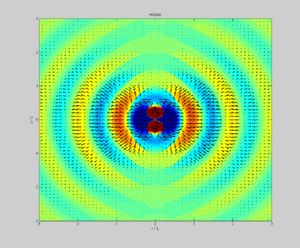
Back Теорема и вектор на Пойнтинг Bulgarian Vector de Poynting Catalan Poyntingův vektor Czech Poynting-vektor Danish Poynting-Vektor German Διάνυσμα Πόυντινγκ Greek Vector de Poynting Spanish Poyntingi vektor Estonian بردار پوئینتینگ Persian Poyntingin teoreema Finnish

| Articles about |
| Electromagnetism |
|---|
 |
In physics, the Poynting vector (or Umov–Poynting vector) represents the directional energy flux (the energy transfer per unit area, per unit time) or power flow of an electromagnetic field. The SI unit of the Poynting vector is the watt per square metre (W/m2); kg/s3 in base SI units. It is named after its discoverer John Henry Poynting who first derived it in 1884.[1]: 132 Nikolay Umov is also credited with formulating the concept.[2] Oliver Heaviside also discovered it independently in the more general form that recognises the freedom of adding the curl of an arbitrary vector field to the definition.[3] The Poynting vector is used throughout electromagnetics in conjunction with Poynting's theorem, the continuity equation expressing conservation of electromagnetic energy, to calculate the power flow in electromagnetic fields.
- ^ Stratton, Julius Adams (1941). Electromagnetic Theory (1st ed.). New York: McGraw-Hill. ISBN 978-0-470-13153-4.
- ^ "Пойнтинга вектор". Физическая энциклопедия (in Russian). Retrieved 2022-02-21.
- ^ Nahin, Paul J. (2002). Oliver Heaviside: The Life, Work, and Times of an Electrical Genius of the Victorian Age. JHU Press. p. 131. ISBN 9780801869099.